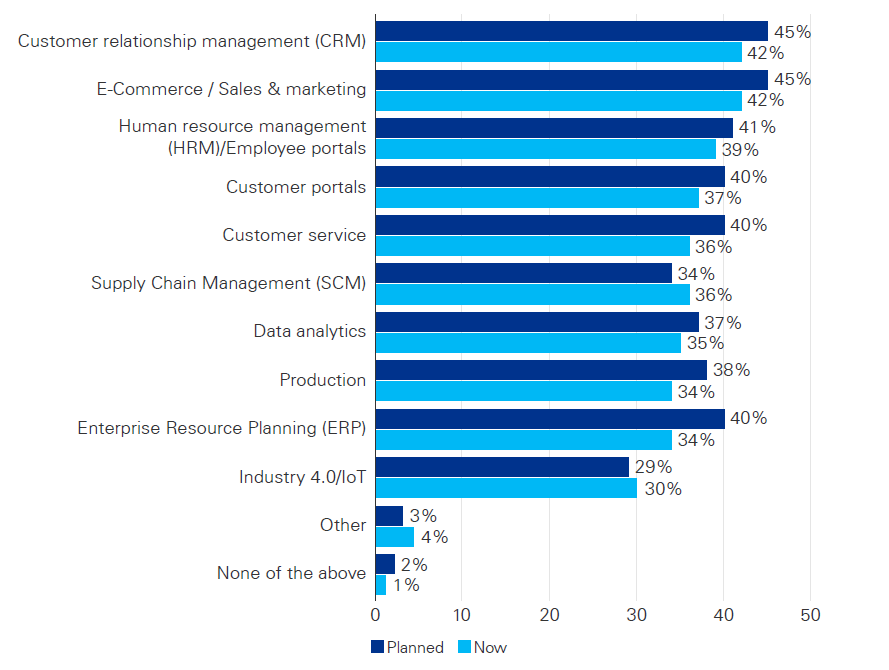Accelerating low code adoption in a slowing economy

Low- and no-code technology platforms have emerged as powerful tools for cost-effective, accelerated digital transformation and development.

As economic headwinds blow, it is a good time to consider how low code can be applied more broadly. In our research, half of IT leaders expect to implement low-code or no-code technology by 2025. With the prospects of a slowing economy and tighter budgets, accelerating low code adoption makes sense.
Low-code platforms enable businesses to develop and quickly deploy new applications and functionality without deep developer involvement or long release cycles. They have been highly effective as low-cost solutions to business process challenges, especially where inefficiencies among business-critical systems exist. Broadly, they have helped organizations meet the onrush of workflow and product demands in an agile, responsive way.
Recognizing the many benefits of low code, companies over the past few years have invested in the technology to accelerate development and push their digital evolution. Though often piecemeal and small-scale, these investments have demonstrated the transformative potential of low code to enhance essential workflows, connect vital systems and deliver point solutions for customers.
During an economic downturn, organizations seeking new ways to save costs and create value have an opportunity to rethink their approach to low code. And they have important new reasons to be motivated. Strained technology budgets, a dearth of developers, pressure to work efficiently and deliver better services and the demands of running a digital-first business all favor a more thoughtful approach to fully adopting low code at the enterprise level.
By optimizing their low-code stack now, companies can begin to achieve near-term cost reductions, improve business resiliency and position themselves with tools that are more responsive to a rapidly changing competitive climate.
The coming low-code boom

Low-code platforms apply a visual approach to building applications, using mostly graphical user interfaces and configurations, unlike the typical software development process that requires manual coding. Many low-code platforms offer an integrated development environment to marry the visual approach with building using traditional coding languages.
No-code solutions, meanwhile, offer what they advertise — a way to develop software without writing any code at all. While both approaches reduce dependence on developer resources, low-code platforms require some coding knowledge, while no-code tools can be used by anyone with just basic computer skills.
Companies have used low- and no-code tools tactically to solve distinct problems, often licensing more than one tool for different needs. In fact, KPMG has found that more than 50 percent of organizations using low-code platforms use more than one simultaneously.
While generative AI technology will disrupt many jobs across enterprises, including the way developers build and maintain software, low- and no-code platforms will still fill an important role in a connected, digital architecture. Analysts predict that low code will become the preferred software development method by 2025. Gartner expects the market to grow to almost $30 billion by then, with a compound annual growth rate of 20 percent. Clearly, the industry has great expectations for low code adoption and utilization. For now, companies are deciding how to transition from selective low code adoption to the cohesive, enterprise-wide approach that would drive these lofty growth expectations.
Analysts predict that low code will become the preferred software development method by 2025.
Low code’s potential

Reducing the time and complexity of software development is a main benefit of low code. So is cost reduction. From a human capital perspective, deploying low-code solutions can influence how IT resources are deployed. Organizations exploring ways to reshape their development teams should consider low-code platforms, not just to plug developer resource gaps but to improve developer efficiency. The tools don’t replace skilled developers, but they do help them reduce the amount of time they spend doing manual coding, even on complex applications.
Low-code solutions can also help break down barriers between business and technology teams by removing the coding black box that often stands between the business’ goals and technology teams’ timelines and deliverables. Low-code projects foster collaboration when the business gets involved in the build process.
Many companies have used low-code tools to improve process efficiency, especially to connect core business systems and streamline data flows among them. Low-code automation tools use visual process builders, business rules engines and case management capabilities to automate processes and workflows. In many ways, business process orchestration has been low code’s most effective application, but there is still potential to apply it, in a cost-effective way, to help businesses connect distinct systems and enhance workflows.
Low code adoption is accelerating in core back-end applications, including enterprise resource planning (Exhibit 1). Today, 34 percent of the companies surveyed in a recent KPMG study conducted in Europe, Middle East, and Africa (EMA) were already using the platforms in ERP, while another 40 percent said they have plans to do so1. Among all the areas of deployment, CRM and e-commerce/sales and marketing are the most common, both at 42 percent, followed by human resources management. In all three categories, more than 40 percent of companies not using low code today have plans to adopt it.

Exhibit 1: Where companies are using low code now and in the future
In which areas of the company/processes do you deploy applications with low-code development? (Multiple answers possible)
There is a visible expansion of low-code solutions into core/back back-end applications space, particularly ERP, which will be even m ore obvious in next few years.
Population = 309 already deployed, 715 plan to deploy
What you can do now
In a tighter economic climate, low code can be a cost-effective and transformational way to deploy technology and to tap into organizational resources to accelerate change. Unlocking the full potential of low code requires companies to address the cultural, technical and economic drivers that lead to its successful implementation, acceptance and operation.
Here are the steps you can take to get started:
1
Rethink your low-code strategy:
In the race to add value and improve efficiency, companies have sometimes taken a patchwork approach to using low-code tools. Separate groups would license different solutions for their own tactical needs. While that is not an inherently wrong approach, it led not only to more institutional complexity, but also to higher subscription costs and more technical debt.
It sometimes created shadow IT operations, too, multiplying operational and security risks. This concern remains a key barrier to low code adoption and an argument for taking an enterprise-level approach. By rethinking low-code strategy now, companies can start to clean up the messy outcomes of their legacy low-code deployments.
2
Refine your business case:
Identify opportunities to accelerate innovation, save costs and improve workflow using low-code tools. Any business process that involves email or calls as part of the workflow — or a “chair swivel” between systems due to a lack of data integration and heavy reliance on paper-based processes — would be an automatic candidate. Define a mechanism to identify and collect those use cases and prioritize them based on value, effort and resources to create a running backlog of use cases to target. Develop a plan that integrates all the potential benefits into a comprehensive business case supporting an enterprise approach to low code.
3
Streamline low-code governance:
Because organizations have sometimes taken a fragmented approach to low-code use, they have missed opportunities to set enterprise-wide standards and practices for low code adoption and to initiate the necessary cultural changes. In fact, just 31 percent of companies using low code today have guidelines and governance in place to manage it, according to KPMG research.
4
Align roles and responsibilities:
It is important to clarify roles and responsibilities in adopting a low-code approach considering the potential impact on everyone’s day-to-day workflows. Better collaboration between business and technology is critical. While leaders across IT and business teams understand the potential of low code, they often fail to agree on how best to collaborate to achieve the benefits of scale and speed that this technology offers. In the past, that’s created barriers to implementing low code holistically into an overall technology strategy.
How KPMG can help
KPMG is deeply involved in helping companies define and implement their digital transformation strategies — and in helping them leverage low-code development platforms to make those strategies come to life. We provide a range of services and are actively working with organizations to define and operationalize strategies, implement governance frameworks, identify use cases and build applications and automated workflows that support cost-efficient transformation using low code.
Dive into our thinking:
Accelerating low code adoption in a slowing economy
Download PDFExplore more
Meet our team
Wherever you are in your low-code journey, our 15,000+ technologists can tailor our vast experiences, field-tested approach and cutting-edge solutions to your unique needs and challenges. To learn more about how KPMG can help accelerate your low-code adoption, please contact us.

